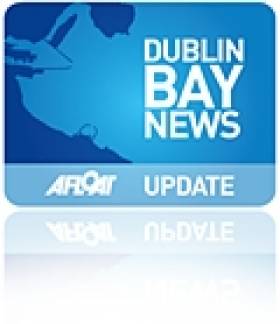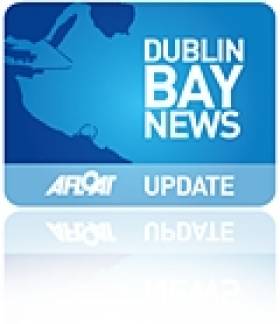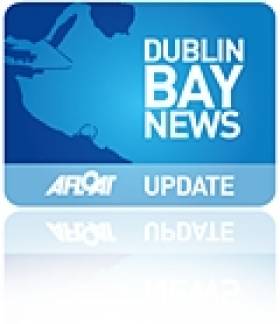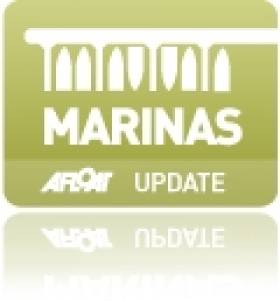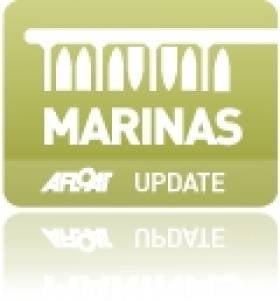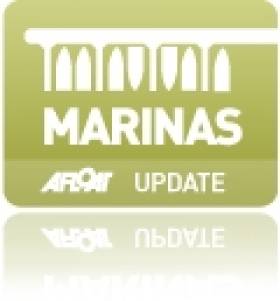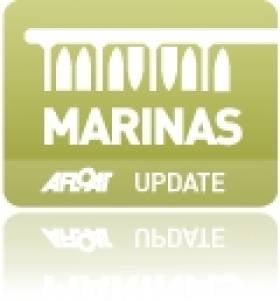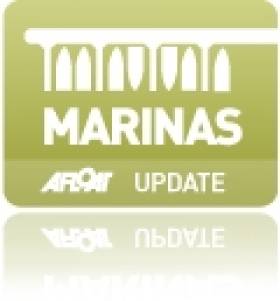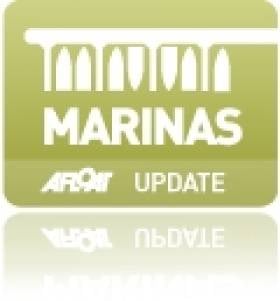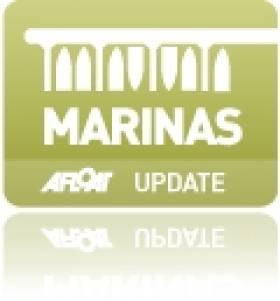Displaying items by tag: berth
New Cruise Berth Plans to be Lodged to An Bord Pleanala
#cruiseberth – Dun Laoghaire Harbour Company on behalf of the Dun Laoghaire Cruise Stakeholder Group will submit its planning application for a new cruise berth facility at Dun Laoghaire Harbour to An Bord Pleanála on Friday, 3rd July.
The planning application is being submitted as a strategic infrastructure project, and members of the public can review the planning application and associated environmental impact report – free of charge - from 9th July in the offices of An Board Pleanála on Marlborough Street, Dublin 1 or at the civic offices of Dun Laoghaire Rathdown County Council. In addition, a dedicated website, www.dlcruiseplan.ie, will contain all the relevant documentation. Once the documentation becomes available for public review, members of the public will also have an opportunity to submit their observations on the plans to An Bord Pleanála.
Plans for the new cruise berth facility have been developed so that Dun Laoghaire Harbour can accommodate next generation cruise ships. More on this here from W M Nixon.
The Dún Laoghaire Cruise Stakeholder Group is made up of Dún Laoghaire Harbour Company; Dún Laoghaire Rathdown County Council; and the Dún Laoghaire Bid Company. Ahead of finalising its plans, the Stakeholder Group carried out a pre-planning public consultation in April. Since then, the plans have been modified to reflect the consultation with harbour users, and the general public.
Speaking ahead of submitting the planning application, CEO of Dun Laoghaire Harbour Company, Gerry Dunne said: "The cruise industry is an important and growing sector of the tourism market. Cruise ships are getting bigger in size, offering more facilities to passengers, but requiring deeper water and longer berths to accommodate them. Over 50% of new ships currently on order are over 300m in length. At present Cobh is the only port in Ireland that can accommodate these vessels at any time. This means that Ireland, as a whole, is losing out on a growing and lucrative tourism market.
"At present, Dun Laoghaire must provide tendering services to large cruise ships in order to bring passengers to land. This is a cumbersome approach, and is a negative factor for many cruise operators. Indeed, in recent weeks, Dun Laoghaire has lost a number of cruise calls to Dublin Port; these large cruise ships can now reverse up the Liffey during high tide. In changing their berthing plans to Dublin Port, cruise operators have been very clear that their only reason for the change rests with the convenience of bringing passengers right on to a berth, both from a safety and efficiency point of view.
"The plans for a suitable berthing facility will put Dun Laoghaire in a prime position to attract cruise business. As a harbour, Dun Laoghaire has been mandated by the Government to exploit its potential as a marine leisure facility, and winning and developing cruise business is a central part of our work in this regard," added Mr Dunne.
Under the plans submitted to An Bord Pleanála, the following will be among the features that will be considered:
· A 435 metre pier, with an underpass to cater for the passage of club launches.
· Dredging of an access channel from outside the Harbour to St Michael's Pier, including a 500m diameter turning circle outside the Harbour mouth.
· A shared-use public and pedestrian zone adjacent to the existing Marina and connecting to the Marina Eastern Breakwater.
· A new high-quality footpath along Harbour Road.
· Ancillary site and landscape works.
#dharbour – RESPONSE TO PUBLIC COMMENTARY ARISING FROM STAKEHOLDER/PUBLIC CONSULTATION EXERCISE HELD IN MARCH/APRIL 2015 CRUISE BERTH PROJECT AT DUN LAOGHAIRE HARBOUR For DUN LAOGHAIRE HARBOUR COMPANY ON BEHALF OF THE DUN LAOGHAIRE CRUISE STAKEHOLDER GROUP
The Dun Laoghaire Cruise Stakeholder Group has responded to concerns raised in a number of submissions made as part of an informal pre-planning consultation process in connection with the proposed development of a new cruise berth facility in Dún Laoghaire Harbour.
It is expected that a formal planning application for the proposed development will be submitted to An Board Pleanala in the coming weeks.
As part of the consultation process the Cruise Stakeholder Group met and briefed local public representatives and stakeholder groups. Full details of the proposal were posted on the Dún Laoghaire Harbour Company website and all those on the company's database were written to. Posters were also erected in the harbour area inviting members of the public to submit their views.
A total of 139 submissions were received. The submissions offered a variety of views, including positive support for the project. A large number of submissions expressed some concerns, and indeed opposition to the project. In some cases opposition / concern was based on a misunderstanding of what was actually proposed or had misplaced concerns about the implications for harbour users.
The Dún Laoghaire Cruise Stakeholder Group is committed to taking into account all submissions made before the planning application to An Bord Pleanála is finalised.
However, in order to address concerns that were raised, the Stakeholder Group has now published a short document summarising the main issues which arose during the informal pre-planning consultation process, along with a succinct response to each issue. A summary of the issues and responses will also available on the Harbour Company's website. This document is now being issued to all those who made submissions, to public representatives and to stakeholder groups. [Scroll down to read this document]
The Dun Laoghaire Harbour Masterplan, published in 2011, identified the need to develop strategies to ensure the long term future of the harbour, in view of the declining importance of ferry traffic. Development of cruise business was identified as one of the opportunities to be pursued. In addition, Dún Laoghaire is designated as a marine tourism port under the Government's National Ports Policy and the development of the cruise business fits into this framework.
Dún Laoghaire will have its most successful cruise season ever in 2015, with 100,000 passengers and crew expected. However the development of the cruise berth facility is essential to allowing up to build on the success to date and to bring even more vessels and passengers to our town.
The expansion and development of the cruise business offers significant economic benefits to Dún Laoghaire and the surrounding areas. These would include expenditure by disembarked passenger and crew; payments to tour operators by cruise companies and purchases by cruise ships from local supplies while in harbour.
The Dún Laoghaire Cruise Stakeholder Group is confident that the cruise berth development can be delivered while preserving the unique heritage of the harbour and without impacting unduly on sailing and marine leisure activities which are such significant parts of the harbour's activities.
Introduction
The Dun Laoghaire Harbour Company on behalf of the Dun Laoghaire Stakeholder Group in the process of compiling a planning application to be submitted to An Bord Pleanala under the Strategic Infrastructure (SID) provisions of the Planning & Development Act 2000, as
amended.
As part of that process it was decided to canvass the views of local people prior to making the planning application in order to seek to accommodate or ameliorate any issues that may arise as part of the application. This was referred to as a 'Phase 1 Consultation'.
The undertaking of this exercise and any involvement in same would not affect people's rights to participate in the planning application process in the normal way.
Phase 1 Consultation
A presentation was prepared in order to provide an over view of the project in terms of what it involves (both during construction and operation), the work undertaken to date and an explanation of the application process that would follow.
A set of Frequently Asked Questions (FAQ's) and responses was prepared in anticipation of the typical queries that would arise.
A page on the Harbour Company web site was set up which included the above presentation, together with accompanying maps of the harbour, along with the FAQ's. This information was available for download.
It was intended to have a two week period in which members of the public could make their views known. The Harbour Company used its database of stakeholders to send a letter inviting participation in this Public Consultation phase. In addition, posters were erected around the Harbour so that Harbour Users would see the consultation was on-going and could participate.
Prior to commencing this Consultation, meetings were arranged with key stakeholders/Harbour Users. These meetings took place in the last week of March 2015.
Overall, the Stakeholder/ public consultation process occurred over a three week period. There have also been a series of meetings both with Dun Laoghaire Rathdown County Council and An Bord Pleanala relating to this project. Those consultations occurred separately to this public consultation process.
Who did we meet?
The following is a schedule of the meetings held prior to the Public Consultation process
commencing:-
Monday, 23rd March:
• Dun Laoghaire Area Committee, Dun Laoghaire Rathdown County Council
Tuesday, 24th March:
• St Michael's Rowing Club
• Sea Scouts/ Kyron O'Gorman
• Irish National Sailing School
• Dun Laoghaire Motor Yacht Club
• Royal National Lifeboat Institution (RNLI)
Wednesday, 25th March:
• Coal Harbour Users Group
• Marina Company
• Dun Laoghaire Business Investment District Company
• Commissioners of Irish Lights
Thursday, 26th March:
• National Yacht Club
• Dublin Bay Sailing Club
Friday, 27th March:
• Royal Saint George Yacht Club
• Royal Irish Yacht Club
Wednesday 1st May 2015
• The Water Wags
Number of responses
In total 139 responses were received during this Phase 1 Consultation phase. Of these, 13 were in favour of the project, 22 made observations or raised queries and the remainder were against, with a variety of issues raised.
In general only a minority of submissions were supportive, some simply raised questions of made broad comment, but the majority expressed opposition to the proposal; in some cases these were based upon a misunderstanding of what was in fact proposed, or misplaced about the implications for harbour users.
What were the issues raised?
In seeking to provide a response at this stage, we have attempted to group common issues under particular headings. This avoids too much repetition in the responses provided below.
From a review of the Submissions made, the following issues arose:-
1. Impact on dingy sailing/youth sailing
2. The cruise berth cuts the harbour in two.
3. Impact on sailing competitions in the harbour
4. Impact on ability to attract International sailing competitions
5. "Wind shadow" effect of cruise ship in harbour
6. Impact on Heritage of the harbour
7. Suitability (or otherwise) for a Victorian harbour
8. Potential for environmental damage and negative impact on bird and marine life
9. Safety/emergency incident plan
10. Rocky nature of harbour bed making dredging difficult
11. Disturbance to mercury in the harbour bed caused by dredging
12. No economic benefit to the town
13. Impact on traffic
14. Legal advice that project is not Strategic Infrastructure Development
15. Too little detail provided about the scheme
16. Consultation period too short
17. Replacement ferry service for Stena
18. Leave cruise business to Dublin Port.
19. Continue with existing cruise tendering operation (ships anchoring in Dublin Bay)
20. DLHC should not be allowed embark on a new venture like this, while a merger with DLRCoCo is pending
Dinghy sailing/youth sailing
It is evident from a review of the comments received that the issue which arose the most often was the impact the proposal would have on Dinghy Sailing/Youth Sailing. In particular, the following activities were raised:-
• Junior Summer Sailing Courses
• Sailability Dun Laoghaire
• Friday Night Racing
• September Series
• Regional and National Optimist Class Championships
• Junior Sailing Regatta's
• ISA National and Regional squad clinics
• Team Racing
• Winter Frostbite Racing
• Summer Tuesday Night Racing
• Winter Coaching
• Dun Laoghaire Regatta
We will have regard to the aspects associated with each of these within the planning application.
Preliminary response to issues
The issues raised through the public consultation exercise will be addressed in a full and comprehensive way as part of the plans and particulars to be lodged with An Bord Pleanala.
At the outset, it is worth recalling that Dun Laoghaire Harbour is first and foremost a working harbour. It also happens to accommodate a marine leisure component which it is recognised and acknowledged contributes to its charm and character. It is also recognized that the marine leisure component of the harbour is a significant part of the harbour activity. This marine leisure activity must and does function in a manner that does not detract from the primary function of the harbour.
To that end, it is worth highlighting that activities within the Harbour are carefully managed and controlled in line with long established rules, referred to as the Notices to Mariners and the Harbour Bye-Laws.
With that in mind, the following provides an initial response to the principal issues raised by members of the public and harbour users generally.
1 Impact on dingy sailing/youth sailing
At present, most harbour users ultilise the harbour as a transit zone between the shore and the bay, where the vast majority of sailing activities occur. This occurs in line with the normal restrictions applying within the Harbour. It is acknowledged that traditionally junior training has taken place in the harbour. All such activity requires the approval of the Harbour Master.
The Notice to Mariners No. 4 defines the Training Area for junior sail training. It states:- "Harbour Recreational Area for Small Craft is the triangular area of the North Bightwestwards of a line from West Pier Lighthouse to the marina west breakwater". Use of the remainder of the harbour by small craft is otherwise restricted, unless and until 'permission' has been obtained. With the removal of swing moorings in 2014, the North Bight area available for raining has been considerably enlarged which has benefitted junior training in the harbour. This will be unaffected by the proposed cruise project
Notwithstanding the Notice to Mariners No. 4, it is recognized that the very junior sailors/beginners associated with the NYC and RSGYC have utilized the sheltered water space immediately around the Carlisle Pier and St. Michael's Pier to learn to sail. Both the IYSC and the INSS use the designated training area at the North Bight.
When competent, the junior training regime then moves from around the piers, to the formal training area and then out to the bay. The INSS use both the Coal Harbour and Seapoint Beach, as well as using the designated training area.
The tradition over the past 15 years or so has been that the more senior/experienced juniors use Dublin Bay itself to train.
It is Dublin Bay that is the 'Major Area of Excellence for Sailing' and the sailing areas that are available now will be available after any cruise berth project has been installed. The designated training area in the North Bight has recently (2014) been extended and will continue to be available.
It has been suggested in a number of submissions that the provision of the cruise berth will prevent the harbour being used for sailing and other marine activity. This argument does not stand up to closer scrutiny. Whilst it is fully acknowledged that the facility will result in some change to the existing patterns of activities for some users, others will see little or no change.
Traditionally, there has been very little 'racing' inside the harbour, other than by the Water Wags, DBSC and the DMYC Winter Series and this has been 'by permission' only.
2 The cruise berth will cut the harbour in two The cruise berth will extend northwards from the existing marina breakwater, from a location to the west of the existing HSS berth.
Even though the berth structures are significant, to allow the berth to accommodate the type of large cruise ship that the cruise lines now favour, there will be a considerable expanse of water within the harbour, north of the northernmost extremity of the proposed berth, which will allow unimpeded travel for boats between the eastern and western areas of the harbour. The total distance from the marina breakwater to the West Pier roundhead is about 0.66 kilometers (660m). The berth will extend northwards for just under two thirds of this distance, leaving just over one third remaining for cross harbour activity.
In addition to the above, the proposed berth will include an underpass which will allow passage between the marina and the areas to the east of the harbour without the need to go around the berth. This underpass will be suitable for use by ribs, launches and other small non-masted craft.
3 Impact on sailing competitions in the harbour There are in fact only a very small number of sailing competitions in the harbour and these occur at particular times of the year only.
As previously noted, all activities within the harbour are subject to an approval process. It is considered that with the adjustments made to the swing moorings at the East and North Bights in recent years that it should be possible for these limited competitions to continue to use the harbour. The Harbour Company is committed to working with the race organisers to find a viable solution within the Harbour.
4 Impact on ability to attract international sailing competitions At the outset we would comment that when international sailing competitions have occurred in Dun Laoghaire in the past, this has imposed severe restrictions on other harbour users.
Appropriate restrictions and safeguards were put in place by the Harbour Master and harbour users adjusted their activities accordingly with little or no fuss for those periods. As regards the loss of such competitions due to the cruise berth project being implemented, it is respectfully submitted that this would not be the case. The continued use of the harbour as a transit zone and holding area as occurred with such events in the past could continue to occur when the cruise berth is in place.
5 Wind shadow effect of cruise ship in harbour Large cruise ships at berth will have an effect on the wind patterns locally, and will result in "wind shadow" downwind of the ship.
The affected area will vary depending on a number of factors, including the size of the ship, the direction of the wind and the speed of the wind. No matter what direction the wind is blowing, there will always an area of the harbour that will be windward of ships at berth and therefore unaffected. This unaffected area of the harbour will always be available for dinghy/youth sailing. It will also be possible to sail in the area affected by "wind shadow" on the leeward (sheltered) side of the ship, with the exception possibly of up close to the ship. Winds blowing roughly parallel to the ship will have little or no "wind shadow" effect. Experienced sailors are familiar with the "wind shadow" effect as their sails create "wind shadow" and a knowledge of this effect is used to gain competitive advantage in racing by manoeuvring to put their competitors in the bad wind caused by the "wind shadow" of their boats.
6 Impact on heritage of the harbour
The development being proposed does not impact on any protected structures, nor does it involve the removal of any heritage structures. The proposal involves the provision of a new berth within an existing harbour and is entirely appropriate as a result. It is acknowledged that part of the Harbour's heritage is its use for marine recreational purposes. This aspect of the Harbour use will not be destroyed by the cruise berth.
7 Suitability of proposal for a Victorian Harbour
There have been quite a number of changes to the activities that occur within the harbour since the days it was first built. The harbour has evolved many times as a result. As already highlighted, it is a working harbour. It is a simple fact that it costs a significant
amount of money annually to just maintain the quality and infrastructure of the harbour. Much of the harbour is old and needs on-going maintenance. The Harbour Company is self financing and needs to generate the required income to sustain the harbour in to the future. For clarity, the Harbour Company receives no funding from Government. The cruise berth is precisely the type of facility one would expect to find in a harbour. With the impending demise of the HSS (which has now occurred), the Harbour Company is looking to attract cruise ships to the harbour. The berth will go some way towards ensuring the viability of the harbour in to the future.
8 Potential for environmental damage and negative impact on bird and marine life This particular issue has been extensively assessed as part of the Environmental Impact Statement being finalized at present.
The preparation of this assessment involved extensive discussions with the National Parks and Wildlife Service, including the Marine Department in Galway and has been conducted by a firm of specialist ecologists. We have been concerned from the outset to minimize any impact the proposal might have on birds or marine life generally and have devised a construction methodology specifically intended to address this.
9 Safety/Emergency Incident Plan
As a working harbour, we can confirm that Dun Laoghaire Harbour has an Emergency Management Plan in place at present in line with the tenets of "A Framework for Major Emergency Management". The current Emergency Plan can be adjusted to take account of the cruise berth facility. The Plan already caters for cruise ship tendering. A Risk Assessment and SOP are in operation for present cruise visits and will be adapted for berth usage.
10 Rocky nature of harbour bed making dredging difficult
As part of the preparatory investigation and survey work undertaken for the project, a programme of ground investigation work was undertaken which included the drilling of boreholes into the seabed in the areas where the proposed berth would be constructed and in the areas to be dredged. It was found that rock was generally located well below the existing seabed and the proposed dredge level. It is therefore not envisaged that any rock or hard material will need to be dredged for the project. This is consistent with the findings of previous investigations in this area of the harbour.
11 Disturbance to mercury in the harbour bed caused by dredging
The area which will require dredging has been the subject of extensive ground investigations as part of the scheme design and Environmental Impact Statement process relating to the project. No elevated levels of mercury have been identified We are aware that mercury has historically been found in other parts of the Harbour near the Coal Harbour. No dredging or marine works are planned for the Coal Harbour as part of this project and as a result no disturbance to the ground conditions will arise.
12 No economic benefit to the town
The Stakeholder Group has commissioned a firm of economic consultants to look in to the economic impacts of the project. Their findings show that there is the very real potential for the town to benefit directly and significantly from the arrival of cruise visits to Dun Laoghaire.
It is estimated that the net economic impact of doing the project for Dun Laoghaire town will lie between €16m and €41m after twenty years, depending on the number of vessels coming into Dublin Bay. The lower number assumes a continuation of historical growth trends in the Dublin Bay market, while the upper limit represents a replication of the success of Copenhagen.
It is recognized that the businesses of the town need to embrace the potential for additional revenue arising from the visiting cruise passengers for this process to be a success. The Cruise Stakeholder Group are confident that Dun Laoghaire will maximize this potential in the years to come.
13 Impact on traffic
The traffic associated with the planned cruise project has been assessed as part of the Environmental Impact Statement process. This shows that the surrounding roads and streets are capable of catering for the traffic associated with the project with relative ease. The project will involve a modest number of coach trips at particular peak periods in the day.
Previously when the HSS was operating five sailings per day (arriving and departing), there was significantly more traffic movements in the area of the project.
It is also worth recalling that there was no particular traffic difficulties with the cruise visits to Dun Laoghaire last year and again when the Royal Princess visited Dun Laoghaire on the 12th May 2015 (3,600 passengers and 1,350 crew). Overall, we are confident that the traffic associated with the cruise project can be catered for
on the existing road network with minimal disturbance.
14 Legal advice that project is not Strategic Infrastructure Development
The project contains a new cruise berth that is greater than 100m in length capable of catering for the new generation of cruise vessels. The Seventh Schedule of the Planning & Development Act 2000, as amended includes a project involving a new berth in a harbour of 100m or more in length as being a project for which the provisions known as strategic infrastructure applies. In line with the requirements of the Act a dialogue with An Bord Pleanala to determine whether the project is or is not strategic infrastructure was commenced in May 2013. An Bord Pleanala have now confirmed in writing that the project is strategic infrastructure and have directed the planning application to be made to An Bord Pleanala directly.
15 Too little detail provided about the scheme
We would respectfully suggest that a significant amount of detail regarding the project was provided at pre-consultation and as part of the consultation. The final project design is nearing completion, as is the EIS that is intended to accompany the application. The outcome of this pre-application public consultation will feed in to the final plans. The full and final detail of the scheme will be available for interested members of the public on a dedicated web site and will also be available at the offices of Dun Laoghaire-Rathdown County Council during the seven week consultation period after the planning application is lodged with An Bord Pleanala. The application will also be available in the offices of An Bord Pleanala.
16 Consultation period too short
The stakeholder/public consultation period took place over a three week period. This was considered adequate to obtain the views of people towards the project. It was made clear in the material provided at this stage of the process that a further much lengthier and formal process of consultation would follow once the planning application for the project was lodged.
The response to the request for comments generated 139 submissions. There will be a full seven week consultation period once the planning application is lodged, during which time observations to An Bord Pleanala may be made. This will afford interested parties with a further opportunity to comment on the final proposals.
17 Replacement ferry service for Stena HSS
We can confirm that the Harbour Company is in discussion with potential ferry operators. Were a ferry service to return to Dun Laoghaire, it would only be a small craft service catering for small numbers of cars and foot passengers. It is not envisaged that by the operators that vessels capable of accommodating freight traffic will come to Dun Laoghaire again. Such a small craft ferry could operate in the harbour in tandem with a cruise berth facility.
18 Leave cruise business to Dublin Port
The National Ports Policy (2013) identifies Dun Laoghaire Harbour as follows:- the long-term future of Dún Laoghaire Harbour Company will be in terms of marine leisure, maritime tourism, cultural amenity and urban redevelopment. The cruise industry will have a major part to play in the realization of these national policy
aspirations for the harbour. It is considered entirely consistent with National Ports Policy to encourage cruise visits to Dun Laoghaire Harbour. It is considered that there is scope for both Dun Laoghaire Harbour and Dublin Port to cater for the increasing cruise industry in Dublin Bay.
19 Continue with existing cruise tendering operation (ships anchoring in the Bay)
Cruise lines will always favour direct berthing to tendering, as it offers a better experience for its passengers and is more reliable. Tender berthing requires a long transit from ships anchored a couple of kilometres outside the harbour in small tender boats. The transit time to and from the ship means that the time available for passengers ashore is shorter than would be the case if the cruise ship were able to berth within the harbour. It is also subject to weather conditions, as conditions may be such that the journey in the tenders is uncomfortable due wind and wave conditions, or indeed, weather conditions are such that it is deemed unsafe for passengers to disembark from the cruise ship onto the tenders, so the visit to Dun Laoghaire is cancelled. A smaller proportion of the passengers and crew on board the cruise ships will come ashore if the ships tender in Dublin Bay than if the ships berth in the harbour and passengers can disembark onto a quay. The provision of a direct berth will attract a greater number of cruise ships, and a greater proportion of passengers aboard those ships will come ashore to explore Dun Laoghaire and its surroundings, as it is easier to come ashore and to get back onto the ship, providing a greater benefit to Dun Laoghaire and
the greater Dublin area.
20 DLHC should not be allowed embark on a new venture like this, while a merger with DLRCoCo is pending
The project promoter is the Dun Laoghaire Cruise Stakeholder Group. The three principal members of this Group are; Dun Laoghaire Harbour Company, Dun Laoghaire-Rathdown County Council and the Dun Laoghaire BID Company.
The planning application is being made with the approval and assistance of Dun Laoghaire- Rathdown County Council which approved the initial expenditure at a Council Meeting in July 2013. Officials from Dun Laoghaire-Rathdown County Council have attended the majority of the project meetings held with An Bord Pleanala and have expressed their support in principle for the project.
#sdls – A new group, Save Dun Laoghaire Sailing (SDLS), has come forward with radical proposals for a re-configuration of the harbour in order to accommodate the proposed Cruise Liner Berth in the harbour, (plans of which were revealed on Afloat.ie last Thursday), while at the same time maintaining the town's pre-eminent role as Ireland's greatest sailing centre.
A spokesperson for SDLS said that the new group's proposals were still only at a very preliminary stage, but the extremely short time lapse permitted for objections or modifications to the Harbour Company's plan has meant that they have had to act in great haste.
However, the spokesperson asserted that the harbour's thousands of recreational sailors are so concerned at some elements of the new plan - such as the rumoured intention to forbid boats manoeuvring under sail only, let alone racing, within the harbour – that they have had no trouble in recruiting supporters, and an ad hoc inaugural meeting in recent days instructed an acting committee to proceed as rapidly as possible.
The underlying thinking behind SDLS's proposals is that the areas of activity for the different interests within the harbour should be clearly delineated. "Good fences make good neighbours" is the group's core philosophy, and with this in mind they have proposed two new in-harbour breakwaters in order that the large area in the centre of the harbour, which is intended for use by the new cruise liner berthing facilities, will be walled off from other areas of the port.
This will be done by a new in-harbour breakwater from St Michael's Pier to the outer end of the present East Pier, and another small in-harbour breakwater closing off the present outer entrance to the marina.
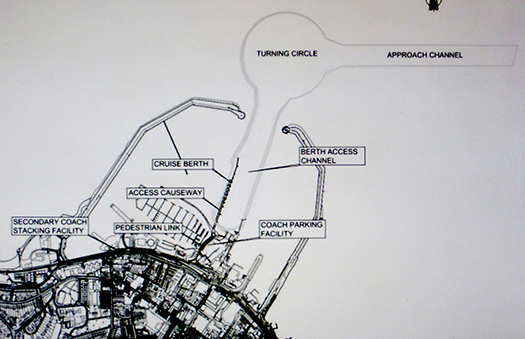
Dun Laoghaire Harbour with the Harbour Company's proposed Cruise Liner Berth occupying most of the space between St Michael's Pier and the harbour entrance
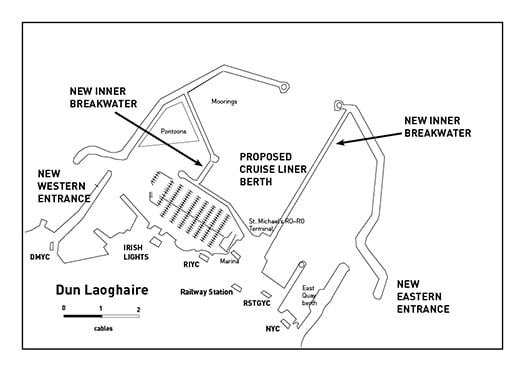
Radical proposals from SDLS (Save Dun Laoghaire Sailing) include new Eastern and Western entrances to the harbour, and two new in-harbour breakwaters which will clearly separate the cruise liner areas from the recreational sailing and boating areas. In effect, three new harbours will be created.
In order to make this feasible, the group has come up with the visionary concept of giving Dun Laoghaire Harbour two additional entrances. The new entrance to the east would be created by making a gap in the existing East Pier, and would inevitably be expensive, as this is exposed to onshore winds, and thus would require a very substantial sheltering breakwater. However, it would still be as cost-effective as possible, as this new Eastern Entrance would not need to be nearly as wide as the current main entrance, as that was created in order to be negotiated by the cumbersome sailing ships of the early 19th Century.
When Afloat.ie pointed out to the spokesperson (who wishes to remain anonymous for the time being) that a gap in the East Pier would result in the ending of the time-honoured tradition of South Dubliners walking the length of the pier on a Sunday, the response was that the demographic is such that an increasing number of South Dubliners are so aged as to be no longer capable of walking the entire length of the East Pier, and thus they would welcome the shorter walk to the lighthouse which will be provided by the new inner breakwater direct from St Michael's Pier.
A further question about the need for manoeuvring space for the cruise liners between their proposed berth and the East Pier elicited the reply that the Harbour Company have already made it clear that they will have to dredge a ten metre channel from the present main entrance to the new berth to serve the deeper drafted liners. Therefore the building of a new pier along the eastern edge of this dredged channel will not impinge on the cruise liners' area of access, and will moreover restrain small craft which might be sailing or racing in the eastern harbour from straying into the liner area.
SDLS is particularly enthused about the possibilities offered by he new western entrance. "For far too long, the West Pier has been more like the Wild West Pier than part of a civilised harbour," we were told. Now, with the new entrance, it will be brought centre stage, and those dinghy sailors from the RIYC, the DMYC, the INSS and the Coal Harbour who were formerly reluctant to venture into the open waters of Dublin Bay will find they have easy access to the relatively sheltered Bay waters between the West Pier and Seapoint.
SDLS conclude their initial policy document by pointing out that their plan would in effect provide the benefit of having three harbours where at present only one exists. And for further diversity, they suggest that the central commercial area for the cruise liners could possibly, in time, also accommodate some working fishing boats, as the colourful activity of hardy fisherfolk is much appreciated by cruise liner passengers
As to the fact that the creation of two new entrances means in effect that there will now be two completely separate leisure harbours on the south side of Dublin Bay with their entrances one and a half miles apart, SDLS argues that this is one of the most attractive features of their plan.
"Sailing enthusiasts from places blessed with natural advantages and numerous little ports of call, such as Cork Harbour, are always bemoaning the fact that when you sail out of Dun Laoghaire, there is nowhere convenient to go to within easy reach. But thanks to our plan, we can now envisage that a boat which has to go to sea via the new West Entrance could go out for a nice sail in Dublin Bay, and then go visiting in the eastern part of the harbour through the new Eastern Entrance, and vice versa.
Having considered these attractive options, we don't see the proposed new cruise liner berth as a problem. On the contrary, we see it as an opportunity to make Dun Laoghaire a much more interesting place to sail from".
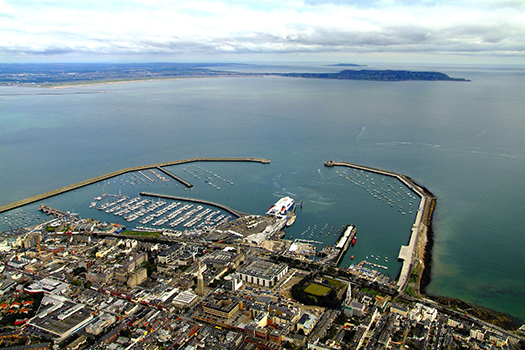
Dun Laoghaire harbour largely as it is today, although the presence of the HSS ferry in port is now history and the contentious new library has been inserted in the tree-surrounded green space at right foreground. Photo courtesy ICC.
Editor's Note: Normally our April 1st special would be pulled at noon. But as virtually all plans for a totally artificial harbour at Dun Laoghaire, ever since the first ones more than two hundred years ago, have been initially treated as an April Fool joke, we think we'll let this one run. And further comments are welcome, for underlying the tomfoolery, a very serious situation is developing for the harbour's future.
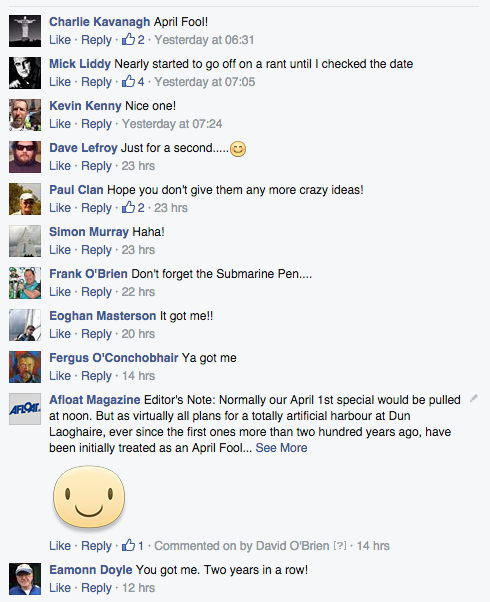
Dungarvan Harbour Sailing Club 30–Berth Pontoon Will Attract Visiting Boats to Waterford
#tourism – A new Dungarvan pontoon facility to provide short term temporary berthing on the Copper coast in West County Waterford has been opened. The facility opened by Dungarvan Harbour Sailing Club will provide berthing for approximately 30 berths on the West Waterford coast. The new facility replaces an older interim structure which had been in place since the early 1990s.
The facility is for Club members on a daily fee basis as well as access for visiting boats. It is expected the latter aspect will support the development of marien tourism on the West Waterford coast.
The facility was opened on 11th of May the Minister for Agriculture, Food and the Marine. Simon Coveney T.D.
Speaking at the opening, the Commodore of Dungarvan Harbour Sailing Club, Joan Moloney, said "This is a proud day for sailing in Dungarvan as it represents another important development in the 68 year history of the club. The modernisation of the pontoon facilities will provide safer boat access for families and sailors and will support tourism development in the town". She then went on to thank those in the club who have worked tirelessly to bring the project to fruition.
Moloney thanked Dungarvan Town Council and in particular the unstinting efforts of Joe O'Flaherty the recently retired Town Clerk and Eoin McGarry of McGarry Construction was also praised for his effective and efficient installation of the facilities together with the suppliers Inland and Coastal. During the project a late technical hitch prevented dredging work being undertaken in addition to the pontoon installation.
Close to where the ferry pulls in to Strangford Village a new pontoon facilty enables visiting boats to berth.
Situated at the head of the Quoile River estuary on Castle Island. There is a short stay pontoon with water hose at Quoile Yacht Club. Visitors can anchor off the moored yachts between Castle and Gibbs Islands. No overnight berthing at the pontoon without permission.
Down Cruising Club is a small, friendly club of approximately 100 members, who are interested in all aspects of boating and cruising on Strangford Lough. The club is fortunate to be based at Ballydorn, on Strangford Lough, and to enjoy the unique facility of club headquarters in the form of the lightship "Petrel"
Visitors to Strangford Lough are advised to examine the up to date chart of the area and keep a close watch for the many perches, some of which are marked and some of which may not be marked. They are also advised to keep a close eye on tides when embarking and disembarking from the lightship pontoon.
On arrival DCC says a visiting skipper must report to the Bar Steward (VHF Ch 16 – Lightship Petrel) or a DCC Flag Officer/Council Member as soon as possible (contact details on Visitors' Information Notice on deck). Berthing instructions will be given according to the size and type of vessel if a berth is available.
Grand Canal Marina, Dublin City. Yacht & Boat Berths in Dublin
The Grand Canal Marina in the inner dock of the Grand Canal Basin has a landmark 'Box in the Docks' building familiar to many Dubliners. The 50-berth facility opened in 2004 and has become an asset for boaters in the city centre especially during festivals such as the recent Tall Ships visits, permitting boating access and overnight stays (albeit via a sealock) in Dublin city.
The Royal St. George Yacht Club in Dun Laoghaire harbour offers fully serviced berthing for yachts up to 70ft with pontoons automatically lit and are equipped with shore power. Nightly rates are available. A security card service for visitors gives access to the Yacht Club.
Arthurstown Pier Pontoon. Boat Berths in County Wexford
Arthurstown Pier is at Waterford Harbour’s eastern shore, seven miles north of Hook Head lighthouse. It is directly east of Passage East. The small quay has a stone bottom. In 2010, following the provision of €56,250 to improve boat access on piers along the Hook Peninsula such as Ballyhack, Slade and Arthurstown Wexford County Council installed a small pontoon facility to encourage leisure boating in the area. As well as local boaters the faciility is also proving popular with local fishermen.


























